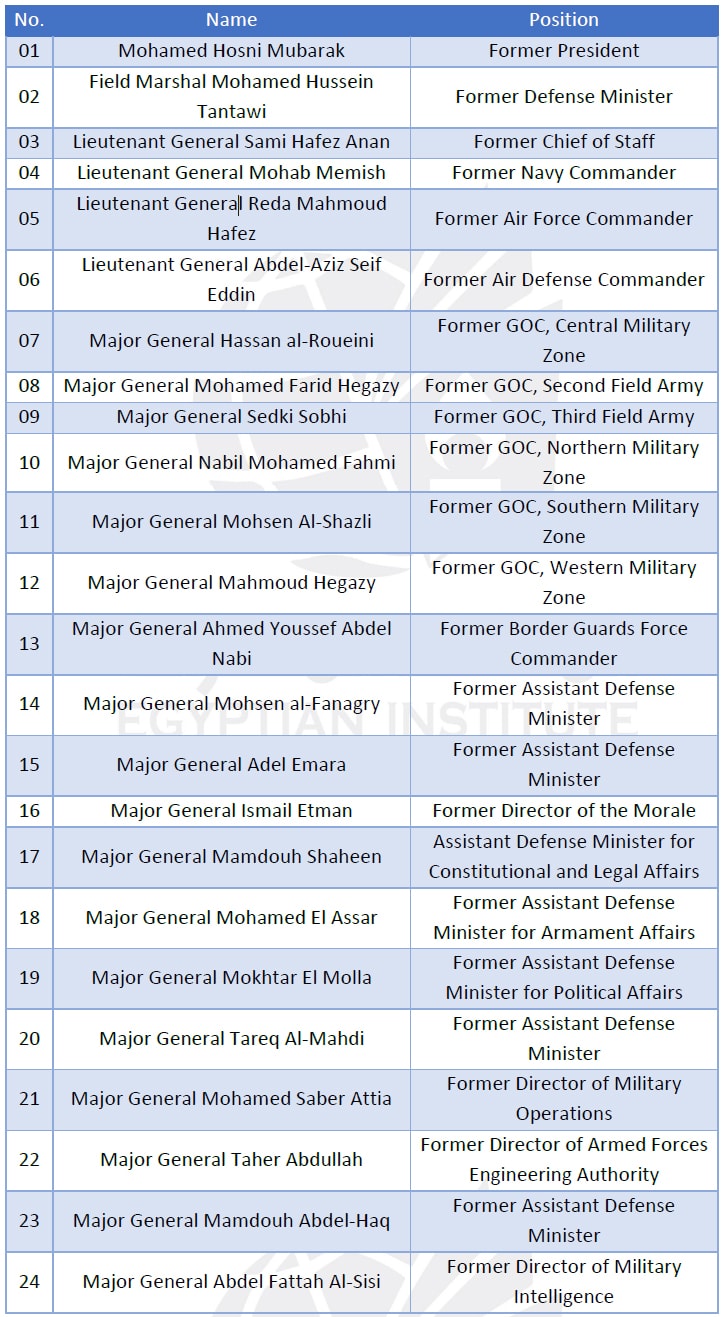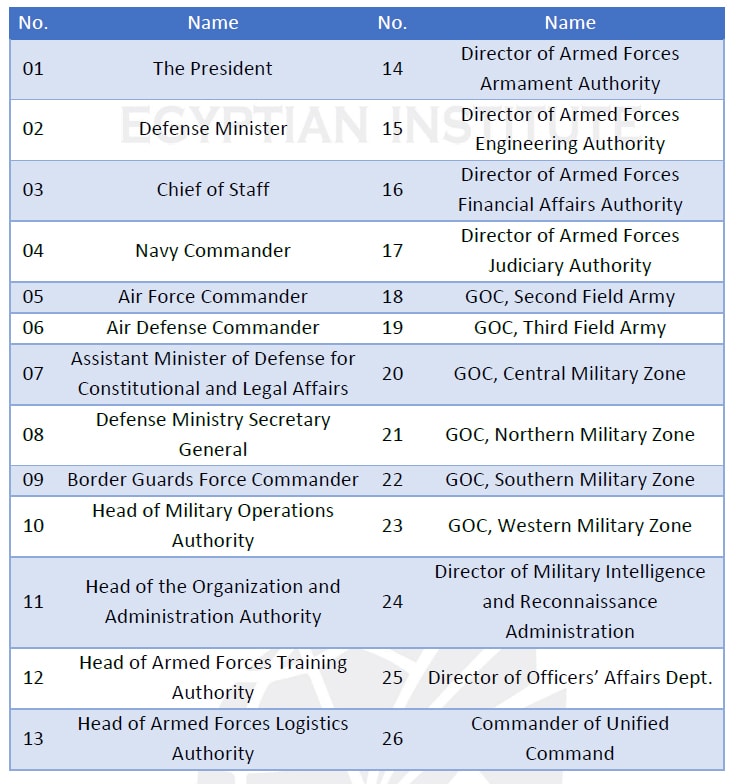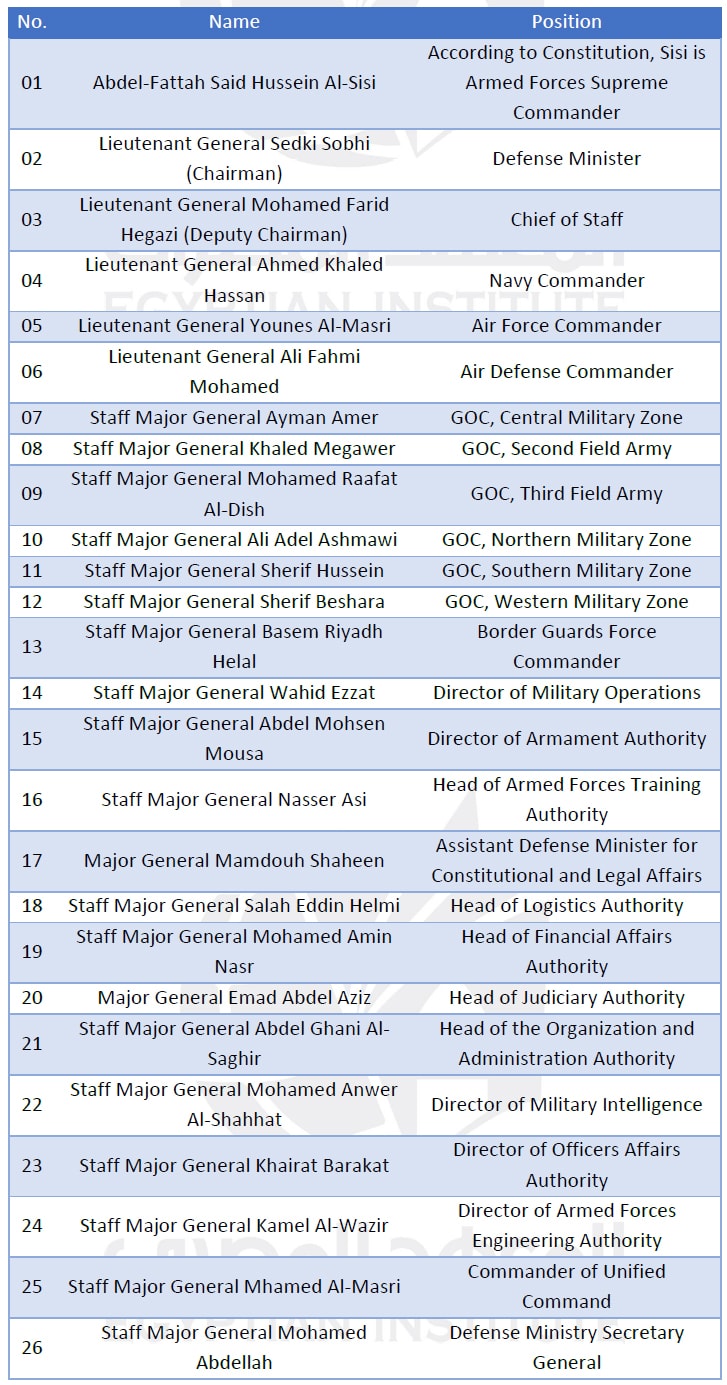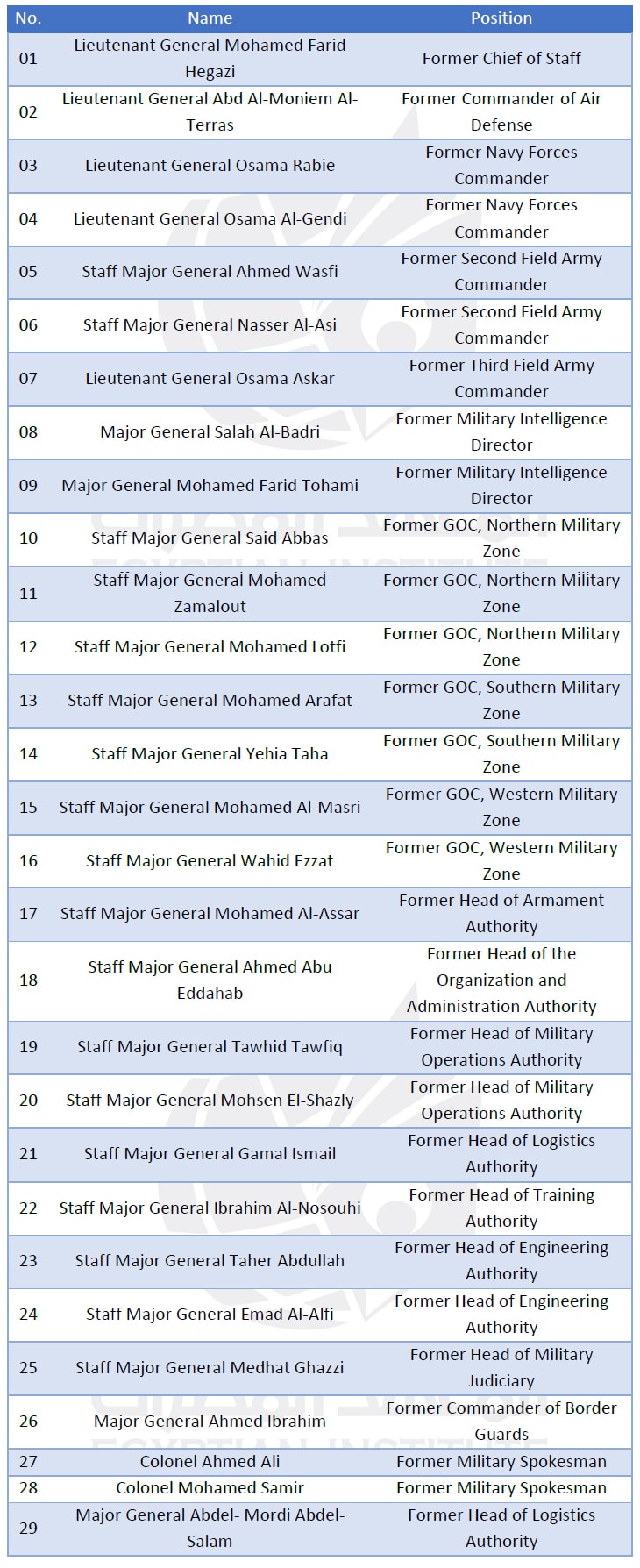
Egypt’s Military Council from Nasser to Sisi
Egypt’s Military Council from Nasser to Sisi
First: Creation and Mission
The Supreme Council of the Armed Forces (SCAF) – Egypt’s highest military body which is sometimes referred to as the “Military Council” – was created by President Gamal Abdul Nasser under Law No. 4 of 1968 following the country’s defeat in the 1967 war. Its official purpose was to coordinate the strategy and operations of the armed forces during wartime, which is why President Anwar Sadat later sought counsel from it prior to the 1973 war.
Yet, SCAF took on a more ceremonial role following the Camp David Accords of 1978 and the Israeli-Egyptian peace treaty of 1979. In contrast to the National Defense Council, the SCAF’s status was not enshrined in the constitution, and it seemed to convene only on anniversaries of past wars during the Hosni Mubarak era. Following the January 2011 uprising that ousted Mubarak, however, the SCAF’s role fundamentally changed.
In mid-2011, SCAF made an extraordinary decision stating that members of the military junta shall remain linked to the army even if they were removed from service, under a call-up commitment, that is they can be called up at any time. Therefore, any SCAF member since 2011 should return to the military junta for obtaining a permission to engage in any public activity such as elections.
Second: SCAF members in the wake of 2011 January Revolution:

Third: Law No. 20 of 2014
According to Law No. 20, 2014 which formalized the new SCAF’s structure and mission, the Council consists of twenty-five members, including the defense minister and chief of staff; and later the number of SCAF members became 26 after the creation of the position of “Commander of Unified Command” to oversee counterterrorism operations east of the Suez Canal. The following table shows this in detail:

SCAF Mission according to Law 20 of 2014
According to Law 20 of 2014, SCAF mission was stated as follows:
1- To define strategic objectives and tasks in order to achieve political objectives as well as objectives of military policy determined by the political leadership of the state.
2- To determine the size and shape of the armed forces, their organizational structure and future development.
3- To maintain the armed forces’ combat readiness.
4- To set the armed forces’ recruitment policy and the bases of mobilization.
5- To develop the policy of harboring the armed forces and study the state of military discipline and morale.
6. To approve the armed forces’ policy of training, including exercises and joint exercises.
7. To approve the policy of military operations theater preparation.
8. To prepare draft laws and regulations governing the service of individuals in the armed forces and proposals for the recruitment system.
9. To approve the policy of maintaining security and safety of the armed forces.
10. To review the reports of commanders of the main branches, heads of bodies, commanders of field armies and military zones, and department managers to determine the state of combat readiness of the armed forces.
11. To study the declaration of the state of war or sending military forces out of the country.
12. To prepare an assessment of the military political situation.
13- To issue the document of the State’s military threats and challenges.
14. To prepare the document of military policy.
15. To prepare the State for war or defense in cooperation with the National Defense Council and the National Security Council.
16- To cooperate and coordinate with the National Security Council in determining the internal hostilities related to the role of the armed forces in this regard.
17- To approve the appointment of the Minister of Defense. This shall be valid for two full terms of office according to the Constitution of 2014.
18- To express its opinion in the declaration of war or sending the armed forces in a combat mission beyond the borders of the State.
19. To discuss any other issues the Minister of Defense submits to the Military Council, such as the country’s economic situation, security situation, and plans to confront protests.
Law 20/2014 Regulations
– Law 20 of 2014 stipulates that SCAF shall consist of the Minister of Defense, as Chairman, the Chief of Staff as Deputy Chairman, Navy Commander, Air Force Commander, Air Defense Commander, assistants to the Minister of Defense, Secretary-General of the Ministry of Defense, Border Guards Commander; heads of the armed forces authorities of Logistics, Armament, and Engineering, financial affairs, and military judiciary; commanders of second and third field armies, and commanders of the central, north, south, and western military zones, as well as Director of Military Intelligence, and Officers’ Affairs Director. The law stipulates that the secretary general of the Ministry of Defense shall serve as SCAF Secretary General. Also, the Minister of Defense shall define SCAF members from among his assistants of various specialties. (Article I / paragraph I)
– A decision by the President of the Republic may include members of the Council from the leadership of the armed forces (Article I / paragraph 2)
– The Minister of Defense shall convene the Council every three months, and whenever necessary. The Council shall not hold a meeting except in the presence of the majority of its members. Decisions and directives of the Council shall be issued by a majority vote of the members present. In case of a war or declaration of public mobilization, the Council convenes on an ongoing basis. (Article II / Paragraph 1)
– The President of the Republic may call the Council to convene whenever necessary, and the President shall preside over the meeting in the event of his attendance (Article II / Paragraph 2)
– The Minister of Defense may invite any of the commanders of the armed forces or any specialists or experts from outside the armed forces to attend the SCAF meeting if the study of the subjects presented requires this, but without having a right to vote. (Article III / Paragraph 1)
– SCAF shall have the right to summon any minister, if necessary, to discuss a particular subject. (Article IV)
– The Council’s decisions shall be issued in the form of a resolution or directive from the Minister of Defense. The minutes and decisions of the Council shall be signed by the Council Chairman and Secretary General and sent to the competent authorities for implementation. (Article V)
Decisions of the Council shall be issued in the form of a decision or directive from the Minister of Defense, and the minutes and decisions of the Council shall be signed by the Chairman and the Secretary of the Council and sent to the competent authorities for implementation (Article 5)
Fourth: Military Council after October 2017
After the dismissal of Chief of Staff of the Armed Forces, Lieutenant General Mahmoud Hegazi, on October 28, 2017, the formation was as follows:

Fifth: Former SCAF members subject to call-up commitment
Alongside the commanders who are members of the Military Council 2017, there are other leaders who are have been considered SCAF members since the 25th revolution, as they are senior commanders within the Egyptian army. However, the new SCAF composition was settled in October 2017. The following are SCAF members who have been dismissed:





